
Ecommerce Email Marketing: How to Redesign Your Campaigns
It’s a week before Black Friday. “Send.” You just launched a great campaign for your store. You have an irresistible offer, eye-catching designs, and clever wordplay. Hopefully, customers will be hooked.
And they are. As soon as they open your email, they click on the offer and visit your eshop. Your sales numbers tell the same story—your Black Friday campaign was a hit.
So, what’s next? Christmas is just around the corner. Then come the winter sales. Followed by Valentine’s Day. Can you repeat Black Friday’s success? How will you win customers over and over again?
Finding new ways to attract your audience. Better words to describe your offers. And fresh designs to showcase your products. These are common challenges for eCommerce professionals. Especially if email marketing is not their full-time job.
Luckily, there are tools and tricks that can do the heavy lifting—helping you create emails that stand out in a crowded inbox. In this blog post, we’ll explore four ways to give your newsletters a fresh look (and boost your sales) without wasting time or resources.
Turn your emails into your storefront
Reach more customers with eCommerce templates, a built-in AI Writer, and campaigns that feature your bestsellers.
Try MoosendSave time with the perfect template
You know the drill. You need to send a campaign, but plain text won’t help feature your products. On the other hand, creating a stunning design from scratch takes time—and skills. And frankly, you just need something that works.
The good news? You can start with a professionally-designed email template and have your campaign ready in minutes. But not just any template. With an eCommerce-oriented template, you can create high-converting campaigns for seasonal offers, restocked items, abandoned carts, and more.
The ideal email template should be both visually pleasing and functional. Make sure to choose a template that:
- Is designed for common eCommerce scenarios so the structure fits your needs
- Drives conversions with easy click-through options
- Is easy to customize and use
Let’s go ahead and see that in action.
Log in to your Moosend account—or create one for free. It’s easy, and no credit card is required. Inside Moosend’s template library, you’ll find 100+ email designs. There’s something for every scenario. Like this Valentine’s Day email template:
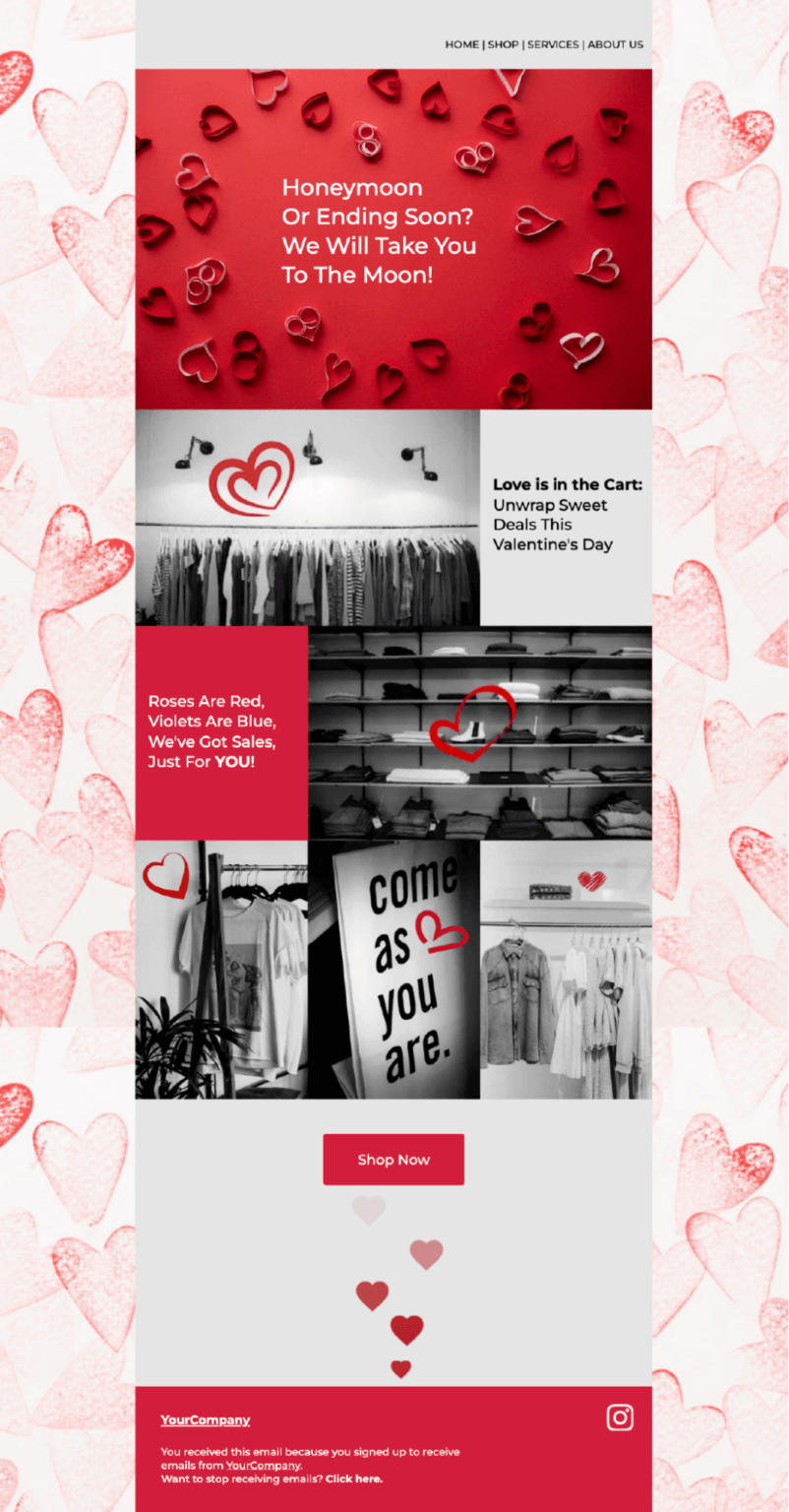
The red color isn’t just a nod at the holiday. It’s also signaling urgency for your Valentine’s promotion, reinforced by the “Shop Now” CTA.
This is the perfect template design to increase seasonal sales.
Of course, there’s more to seasonal sales than Valentine’s Day. Moosend’s template library offers eCommerce templates for major holidays and awareness days, like Black Friday, Christmas and New Year’s, and Mother’s Day.
But let’s say you have a different eCommerce goal, like a new product launch. You can use a template like this one:
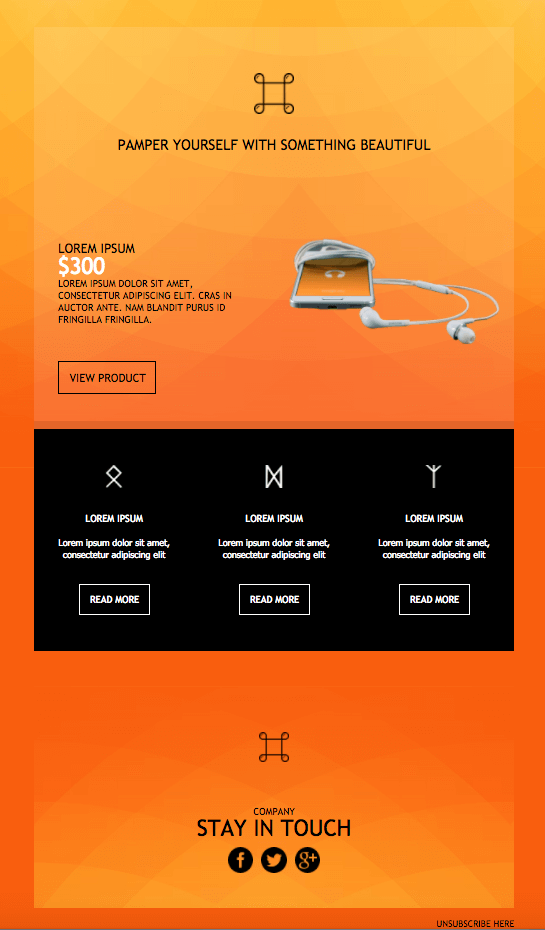
This template is perfect for a dedicated email campaign promoting a new product. It’s geared towards a single product but gives eCommerce professionals three very important options. They can:
- Promote related products based on what users have previously viewed or purchased—perfect for upselling or cross-selling with dedicated product blocks
- Showcase content specific to the product they’re promoting
- Create a virtual display of their best sellers or the products customers abandoned in their carts
Let’s assume you have created an email to promote your brand-new product—in our case, a green dress:

But you don’t want to miss out on users who might like similar dresses in different colors. Or items to match that dress. Let’s see what you can do.
Select the product block in Moosend’s drag-and-drop email designer and connect your eCommerce store, to promote similar products. The result should look like this:
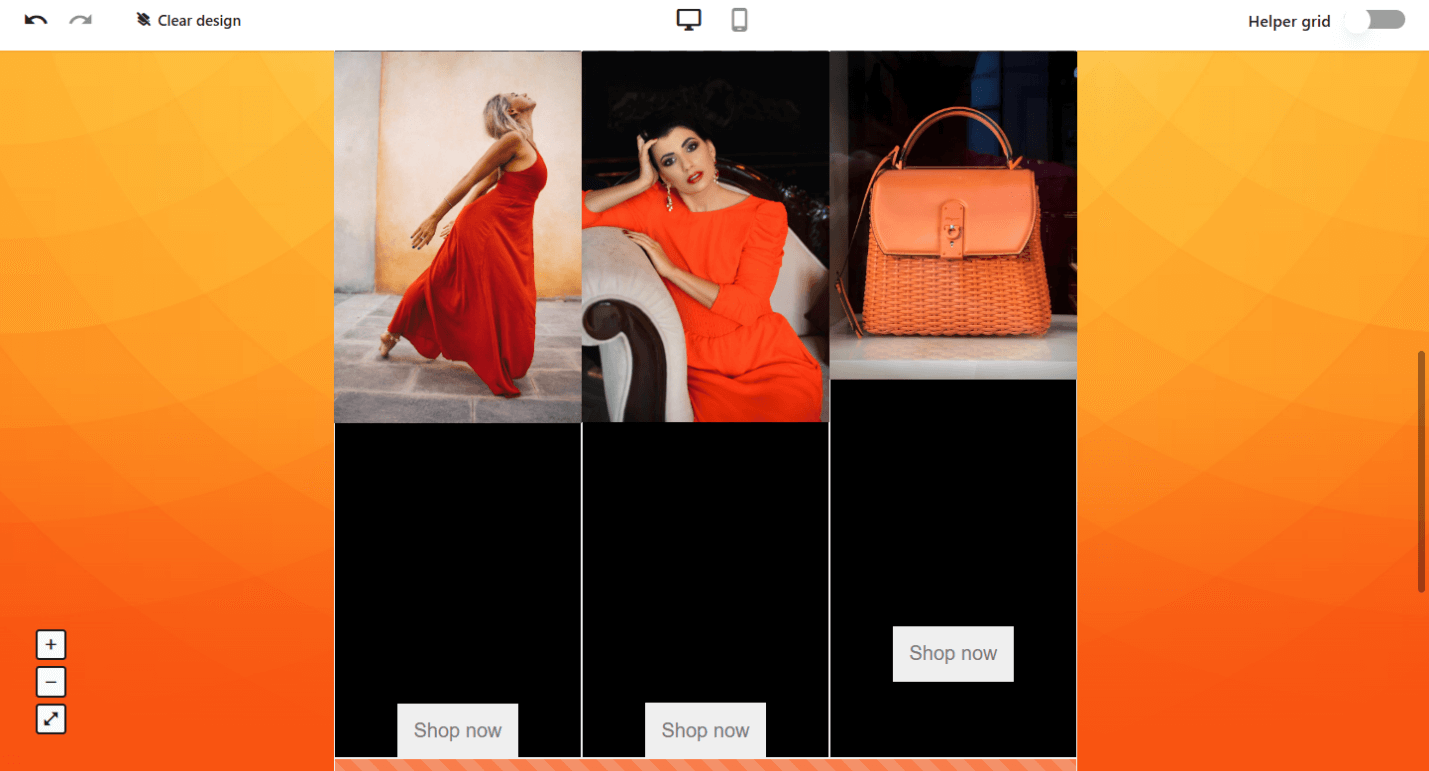
Adding your brand’s unique touch is a crucial element of your template design. Make sure the template you’re going to pick is not just plug-and-play, but also fully customizable to reflect your tone and goals.
In our example, the eCommerce professional wanted to promote more products and used the “Product” block to replace the black blocks of the original template. But let’s assume you don’t have the time, or you don’t want to add anything extra. You just want to promote your new product. In that case, you can simply delete the block.
Or perhaps you want to add similar products and top products. You can duplicate the block as many times as needed.
Why should you pick a ready-made template?
Think of this scenario: You decide to run a last-minute discount campaign for the remaining stock of your Halloween items, only to realize that there’s simply no time to design a new email from scratch.
What are your options? You could send no email at all and focus on promoting your discount through social media, but then you risk nobody taking the time to see it.
Or you could send a plain-text email, but then you’re risking your brand’s overall look-and-feel.
Luckily, ready-made templates can get you out of this situation without any hassle at all, as some of them don’t even need to be customized.
The layout is set and ready, you don’t need to give extra tasks to your designer or take up on designer responsibilities yourself. The hard work of design and layout is already done for you, and it only takes a couple of clicks to get a polished, ready-to-go email.
This allows you to save time and resources for more pressing matters, especially during periods like Christmas, Black Friday, or if you’re running a big sale.
Ready-made templates come with an essential perk: They’re pre-optimized for mobile. With mobile email marketing on the rise and an increasing number of shoppers checking their emails on the go, sending non-optimized newsletters is a no-go.
Refine your content with AI
If your email design is the window to your shop, your email content is your salesperson. For your flash sale, re-engagement email, or upselling and cross-selling campaigns to stand out, your email content needs to be compelling, personalized, and strategically crafted for each stage of the buyer’s journey. And with short attention spans, you only have seconds to turn an email opener into a paying customer.
But writing attention-grabbing, conversion-oriented, and typo-free copy takes time and effort. And during peak seasons like Christmas, Valentine’s, or Mother’s Day, time is not something you can really afford.
Luckily, most email marketing platforms can take over and save you time on brainstorming, writing, and refining your emails. AI-powered tools can generate high-quality content in seconds—with a simple prompt.
And it’s not just subject lines or CTAs. AI writers can generate full email body copy, product descriptions, one-liners, whatever your campaign needs.
Picture this: You’re trying to create the perfect Valentine’s Day email newsletter, but you’re stuck. Which words will be catchy and engaging without feeling too salesy or pushy? An AI writer can resolve this issue, freeing up time for more complex tasks.
Besides saving time, an AI writer can also help you:
- Keep consistency across campaigns. The AI writer can help you maintain a uniform tone and style.
- Eliminate human error. AI writers can be your extra pair of eyes, fixing grammatical errors, rewriting awkward phrasing, and polishing your email copy.
In Moosend, using the AI writer is quite straightforward. The tool is built-in, meaning you’ll never have to take your content to a different tool and back to Moosend.
All you need to do is combine the necessary elements to come up with the perfect prompt:
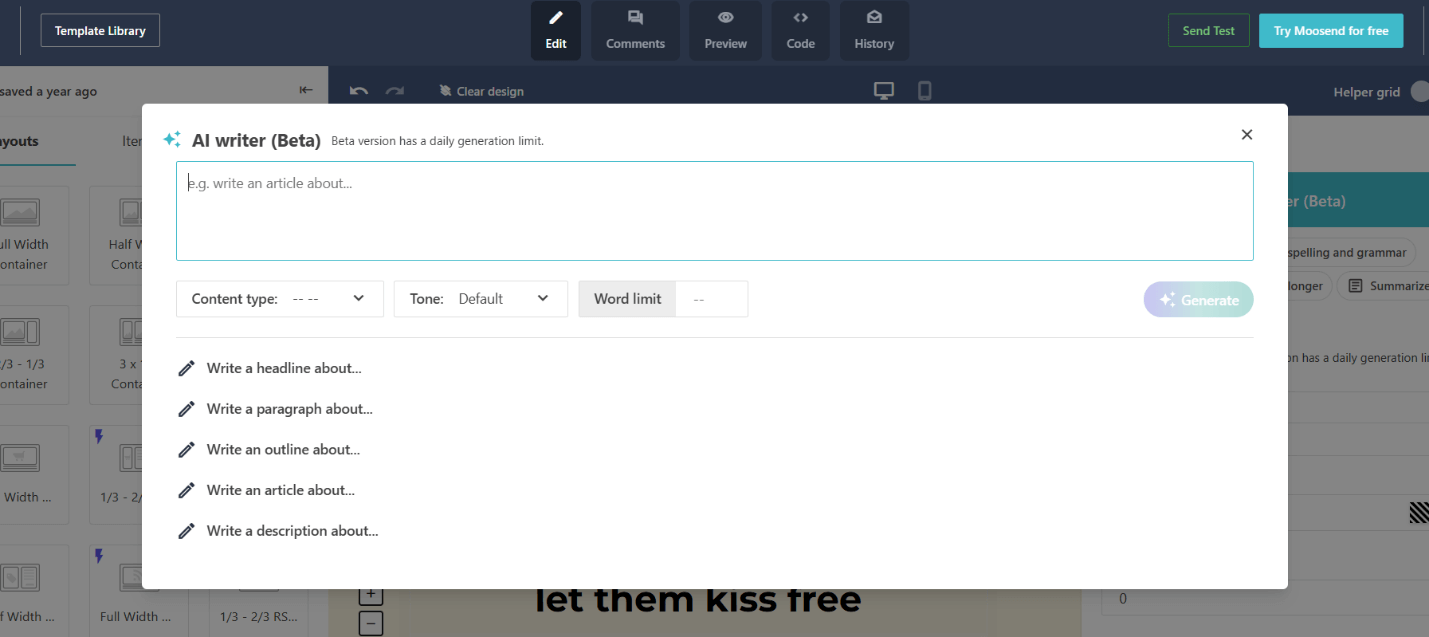
You can ask it to write any type of content, like a headline, an article, or a description. After that, all you have to do is set the content type, the tone, and the word limit, and you’re sure to have professional-looking copy every time.
If you don’t like the first version, you can always regenerate the content until you love the result. The same goes for subject lines and CTAs.

And if you’re not happy with the result, Moosend’s AI writer gives you the added option of bettering your content without needing another prompt. Just ask the tool to improve your writing, fix your spelling and grammar, whatever fits your needs:

Another use of AI is that it can be your personal brainstorming buddy. By writing prompts and getting auto-generated results, you can spend more time refining the final copy instead of searching for the perfect first idea. And less time brainstorming means more time to focus on other aspects of your eCommerce campaign.
You’ve probably heard bits and pieces of these benefits before—especially when it comes to AI writers. But there’s another hidden one not many marketers think of.
When you use a built-in AI writer, you can see what your copy looks like in your email as the tool generates it and make any necessary changes right on the spot.
Differentiate your campaigns with conditional visibility blocks
AI writers can tackle the copy generation issue, but how can you differentiate your eCommerce content while saving time?
As you know, no two customers are the same. There are loyal shoppers who follow your store and come back to you for their necessities. There are customers who are brand new and just exploring their options. And there are the in-betweeners who will occasionally shop from your store.
So, why send them the same email? If your answer is “because I have no time to draft different emails for different people,” keep reading.
Your solution here would be a conditional visibility block. Conditional visibility blocks include dynamic content that you can segment for each group of recipients.
You can use conditional visibility blocks to:
- Offer exclusive discounts to loyal customers, rewarding them for always coming back to your eCommerce store.
- Showcase new arrivals or giving an incentive as a “Welcome” to subscribers who have recently joined your list, enticing them to make their first purchase.
- Promote relevant products based on customer preferences, browsing history, or past purchases.
But how can you make this work?
Conditional visibility blocks are part of your email, just like an image or a call-to-action. They give you the flexibility to tailor content dynamically and choose which recipient can see your offer. So, exclusive offers can be shown to VIP customers while offers for the first purchase can be shown to first-time buyers.
Whether you need to personalize promotions, target different customer segments, or simply hide content from certain audiences, these blocks make customization effortless and intuitive.

As you can see in the image, there’s a “Conditional visibility” section, where you set the settings of who can see the block with your offer and what this offer is.
Using the example above, imagine that you run a cosmetics eCommerce store. Instead of creating individual eCommerce campaigns—one for, say, skincare, and one for perfumes—you can use Conditional visibility to showcase content to users interested in the former or the latter.
Or let’s assume you’re running a campaign with different time-sensitive offers, like a replenishment email campaign for perishable goods.
Instead of creating different campaigns for different timeframes and losing precious time, you can just use a conditional block and set specific dates for each product you’re promoting.
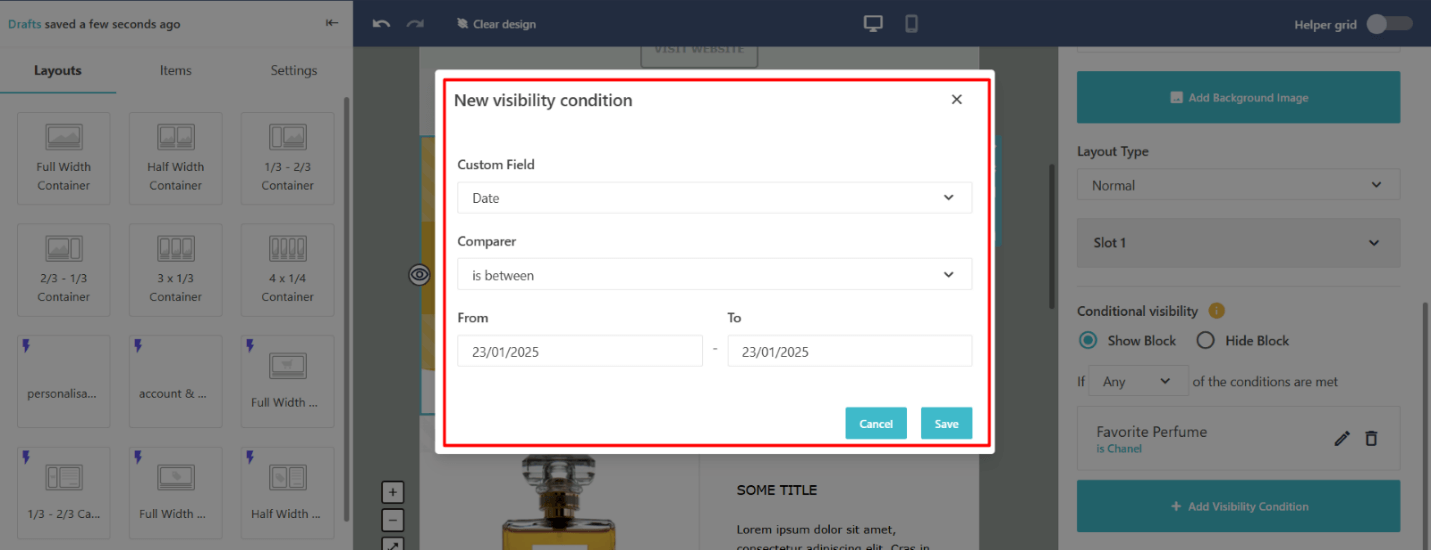
Using our example, you’ve got at least two different emails within one template, only by choosing the conditions for each block. Using conditional visibility as an eCommerce professional can help you:
- Save time by creating what could be characterized as one “master email” with up to 10 different visibility conditions, reducing workload and ensuring consistency.
- Increase relevance by only showing users content they are bound to interact with.
- Increase conversions because of increased relevance. Users who interact with your content are more likely to proceed with a purchase.
Conditional visibility blocks help you deliver curated experiences that resonate with your audience and make you stand out in a crowded inbox just by changing parameters. No copy and pasting content, no duplicating layouts, no switching tabs.
Choose the campaign type that suits your audience
Now that you’ve created the perfect email with ready-made solutions, it’s time to incorporate the right campaign type into your email marketing plan as a whole.
Surely, you’ve got a lot of different eCommerce campaigns in mind, like promotional and transactional emails. But what are those that can engage your audience and help you meet your desired sales targets?
The “Welcome” email series
A warm welcome for your eCommerce store goes a long way towards creating a lasting impression—and boosting your conversions as well.
Instead of sending one generic email, consider creating a welcome email series that will consist of the following parts:
- Start with a warm welcome and an exclusive free shipping offer that will encourage an initial purchase.
- Next, showcase products that correlate with users’ browsing behavior. That way you increase the chances of a purchase and make customers feel they are reading a unique email tailored to their needs.
- Finally, use urgency, like a limited-time discount code, to lead customers further down the funnel. Some social proof or a chance to join a loyalty program and have early access to offers could do the trick, too.
When creating your series, don’t forget to use personalization elements, like location-specific promotions or dynamic content through the Conditional Visibility blocks.
If you’re already familiar with the process and would like to take it a step further, send—or omit—an email from the series according to user behavior. For example, customers who took your suggestions and completed a purchase from the first email of the series don’t need to receive a limited-time discount.
A welcome email series gives you enough room to showcase your brand, set the tone, and create a connection by introducing your most popular products and current promotions.
Make sure to refine your campaigns over time using metrics like open rates, unique link clicks, and click-through rates.
The essential transactional emails
Most eCommerce professionals use transactional emails, but there is a large chunk that still overlooks their marketing potential.
Transactional emails can be amongst the most-read emails in a customer’s inbox, making them the perfect place to upsell or cross-sell in a way that is subtle but very effective.
For example, when you send an order confirmation, include personalized product recommendations that upgrade or complement the product the user has already purchased. This way, you can boost conversions and customer lifetime value.
But apart from an upselling opportunity, your transactional emails offer you the real estate to establish yourself as an industry leader. So, don’t shy away from including educational content like the best ways for consumers to use their new products, or links to related resources.
Elements like the ones above can turn a routine email into what could be a memorable interaction.
Newsletters for promotions and new arrivals
Your products are the heroes of your newsletters—and they should be. But, sometimes, showcasing your products and introducing new ones is not enough. It’s not just about what you share; it’s also about how you share it.
For example, in your promotional newsletters, you could share behind-the-scenes pictures and stories to show items from production to delivery. Or customer testimonials to describe how other people use your products.
Consider adding interactive features or gamification elements to spice things up. Make your campaigns more engaging with GIFs, quizzes, and Moosend’s Wheel of Fortune that gives people the chance to get extra discounts.
You can also keep your brand top of mind even when you don’t have new items to share. For example, you can create a newsletter campaign when certain items are back in stock—or even when you’re about to run out of stock, for that extra sense of urgency. That way, you’re giving customers the feeling of inclusion. You’re not just an eCommerce brand; you’re their eCommerce brand.
Seasonal promotions and special events
Picture this: It’s summer sales. You’re sending a newsletter to your customers promoting your discounts. But so are all your competitors. How will your brand stand out?
Here’s how to make people click on your email—and add items to their cart:
- Come up with tiered discounts based on engagement and offer exclusive access to prestigious products to your VIP customers first. To do so, identify high-engagement subscribers and reward them with an exclusive early-bird promo before opening the sale to the rest of your list.
- Instead of a discount, offer a seasonal gift-with-purchase deal. This can increase a customer’s Average Order Value (AOV) without breaking the bank. Just offer a limited-edition seasonal product as a gift for orders of a certain value and create urgency without compromising your bottom line.
- Offer mystery bundles that include seasonal or unreleased products. Send your customers a “mystery offer” email with exclusive rights to never-before-seen products and ask for their feedback. It feels like including customers in the decision-making process and makes them feel like they’re more than just consumers, and actively a part of your brand. You can take it up a notch by requiring them to click through to reveal what their “mystery deal” is, without revealing the products included.
- Send a post-purchase email after any major holiday purchase and re-engage users with upselling opportunities. For example, if your customer has bought a new phone as a holiday gift, you can bring them back with phone cases that match the phone—and their aesthetic. To understand what their aesthetic is, just take a look at their browsing behavior on your website and combine the data with their purchases.
Ready to create a brand-new eCommerce campaign?
Now you have all the tools you need to create eCommerce email marketing campaigns that truly make a difference, stand out in a crowded inbox, and delight shoppers.
Implementing the tips above will help you take the first step and nail the look and feel of your eCommerce email every time.
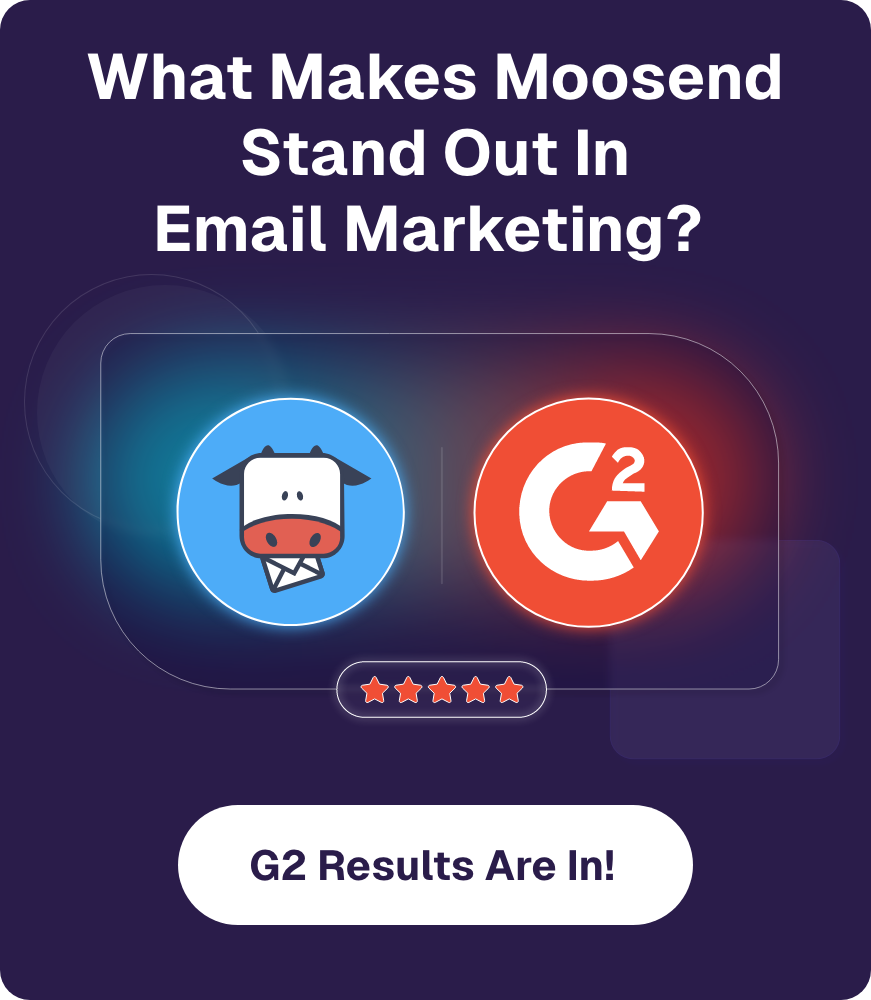


 Published by
Published by
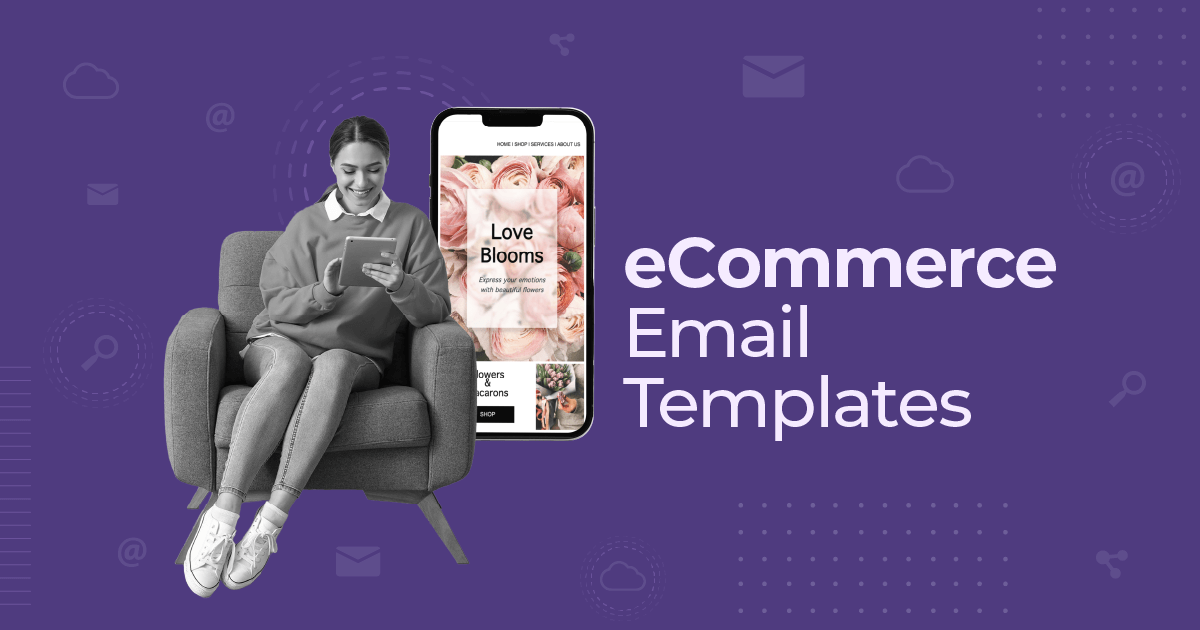
 Published by
Published by
